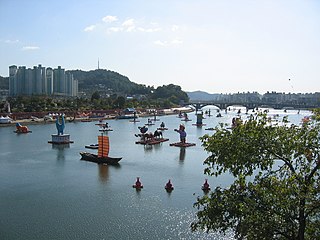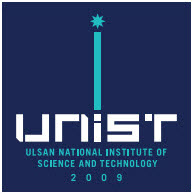
South Gyeongsang Province is a province in the southeast of South Korea. The provincial capital is at Changwon. It is adjacent to the major metropolitan center and port of Busan. There is UNESCO World Heritage Site Haeinsa, a Buddhist temple that houses the Tripitaka Koreana and attracts many tourists. Automobile and petrochemical factories are largely concentrated along the southern part of the province, extending from Ulsan through Busan, Changwon, and Jinju.

Ulsan, officially the Ulsan Metropolitan City, and nicknamed Hyundai City, is South Korea's seventh-largest metropolitan city and the eighth-largest city overall, with a population of over 1.1 million inhabitants. It is located in the south-east of the country, neighboring Busan to the south and facing Gyeongju to the north.

Daegu, formerly spelled Taegu and officially known as the Daegu Metropolitan City, is a city in South Korea.

Gochang County (Gochang-gun) is a county in North Jeolla Province, South Korea. It is a rural area, and is home to only one institution of higher education: Gochang Polytechnic College.

Seosan is a city in South Chungcheong Province, South Korea, with a population of roughly 175,000 according to the 2017 census. Located at the northwestern end of South Chungcheong Province, it is bounded by Dangjin City, Naepo New Town, Yesan-gun and Hongseong-gun on the east and by Taean-gun and the Yellow Sea on the west, and is 125 km (78 mi) south of Seoul, 159 km (99 mi) northwest of Daejeon and 34 km (21 mi) northwest of Naepo New Town. Seosan is the hub of transportation of the west coast where the Seohaean Expressway, Daejeon-Dangjin Expressway, National Highways No. 29, 32, 38 and 45 intersect. This city has great traffic conditions towards the metropolitan area and major cities.

Geoje is a city located in South Gyeongsang province, just off the coast of the port city of Busan, South Korea. Daewoo Shipbuilding & Marine Engineering in Okpo and Samsung Heavy Industries (SHI) in Gohyeon are both located on Geoje Island. The city also offers a wide range of tourist sights. The city is made up of a number of islands, of which by far the largest is Geoje Island. There are multiple dong in the city: Jangpyeongdong, Okpo-dong and Gohyeon.

Jinju is a city in South Gyeongsang Province, South Korea. It was the location of the first (1592) and second (1593) Sieges of Jinju by Japanese forces during the Imjin War. The Republic of Korea Air Force Education and Training Command is located in the eastern part of the city. There are cultural-historical tourist attractions in Jinju such as Jinju Castle, the Jinju National Museum, and the Nam-gang Prehistoric Site Museum.

Miryang, formerly also spelled as 推火郡(probably pronounced as Milbeol or Miribeol using Idu script), Milbeol(密伐) and Milseong(密城), is a city in Gyeongsangnam-do Province, South Korea. Its name is originated from the tribal country named Miri midong guk(彌離彌凍國). There are various hypotheses as to the meaning of Miryang, such as Milky Way, Galaxy, dragon's field, The Wheat Field and the watery field. Neighboring cities include Changnyeong to the west, Cheongdo to the north, Ulsan to the east, and Yangsan, Gimhae, and Changwon to the south. The city bird is the Korean magpie, the city tree is the pine, and the city flower is the royal azalea.

Mungyeong Saejae is a mountain pass in central South Korea. It lies on Joryeong Mountain between the main peak (1017 m) and Sinseon Peak (967 m). The pass itself rises to 642 metres (2,106 ft) above sea level. Mungyeong Saejae connects Mungyeong City, North Gyeongsang province with Goesan County in North Chungcheong province. Water flowing down from the Mungyeong side of the pass eventually flows into the Nakdong River and meets the Sea of Japan at Busan. Runoff from the Goesan side eventually flows into the Han River, which passes through Seoul to meet the Yellow Sea at Incheon.

A show cave — also called tourist cave, public cave, and in the United States, commercial cave — is a cave which has been made accessible to the public for guided visits.

The Howe Caverns is a cave in Howes Cave, Schoharie County, New York. Howe Caverns is a popular tourist attraction, providing cave-goers with a sense of caving or spelunking, without needing the advanced equipment and training usually associated with such adventures.
The Miryang River is a tributary of the Nakdong River which flows through Miryang City. It rises in Ulsan metropolitan city, on the slopes of Gohyeonsan, and flows for 101.5 kilometers before joining the Nakdong in Miryang's Samnangjin-eup. Its narrower upper reaches are often called the Miryangcheon, or "Miryang Stream."
Pyochungsa, originally Jungnimsa, is a Korean Buddhist temple of the Jogye Order of Korean Buddhism. It stands on the slopes of Jaeyaksan mountain near Cheonhwangsan in the Yeongnam Alps in Danjang-myeon, northern Miryang, South Korea.

Jung District is a gu in southern central Ulsan, South Korea. Its name literally means "Central Ward". Most of the population live between the southern border of the River Taehwa and Ring Road. The current head of the district is Park Sung-min (2018).

Nam District (Nam-gu) is a district of Ulsan, South Korea. Its name literally means "South Ward".

Waeseong in Jukseong-ri, Gijang is located in Gijang-gun, Busan Metropolitan City, the Republic of Korea. This is a stone fortress built by the Japanese general, Kuroda Nagamasa who was defending this area against the Korean Joseon army, in about June, 1593, the second year of the Japanese Invasions.

Ulsan National Institute of Science and Technology, simply referred to as UNIST, is one of the four public universities in South Korea which are dedicated to research in science and technology, along with KAIST, GIST, and DGIST. UNIST was founded in 2007 in response to growing demand for higher education in the Korean industrial capital of Ulsan, where world-renowned automotive, shipbuilding, petrochemical, and secondary cells industries are clustered. At the time of its foundation, UNIST was known for being the first national university in South Korea to be incorporated and thus administered by an independent board of trustees despite being funded by the central government.

Ulsan Jungang Market or Ulsan Central Market is a traditional street market in Jung-gu, Ulsan, South Korea. It is the largest traditional market in Ulsan. The market contains many shops that sell fruit, vegetables, meat, fish, breads, clothing, and Korean traditional medicinal items. The market also has many small restaurants and street-food stalls. The market is also home to "Barbeque Eel ally", which is a street famous for the many restaurants serving freshly-killed barbequed pike eel that can be found there.
Ulsanbawi, sometimes spelled Ulsan Rock, is a rock with 6 peaks. It is situated in Seoraksan National Park in Sokcho, Gangwon Province, South Korea. Ulsanbawi is one of the primary attractions of Seoraksan, along with Heundeulbawi, Biryeong waterfall (비룡폭포), and Yukdam waterfall.



















